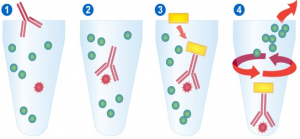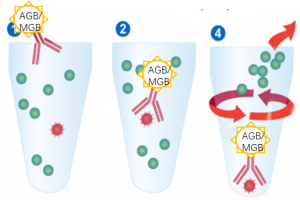The immunoprecipitation utility arranges the IP/Co-IP experiment well
IP experiments are the choice of proteomics research partners when we need to concentrate proteins in small amounts and perform a single assay.
Co-IP is almost mandatory when we need to demonstrate protein-protein interactions. Using cell lysis samples, the interaction of intracellular proteins was proved and the molecular mechanism of the phenomenon was elucidated.
The co-IP experiment is, in a nutshell, a little game of love-hunting in which antibodies capture proteins (antigens) and beads capture antibody-antigen complexes. Now, the IP/ co-IP experiment could eliminate many of the tedious steps involved in the love-making process by "binding" beads to antibody-antigen complexes.
The editor takes you to sort out the steps and attention points of the traditional IP/ co-IP experiment and the optimized and upgraded IP/ co-IP experiment, so that you can remain invincible in the pursuit of love.
Basic steps for traditional IP and Co-IP:

- Add appropriate antibodies.
- Antibodies bind to target proteins.
- Add Protein A/G to insoluble antibody-protein complex.
- Centrifuge the solution to separate the antibody-protein complex.
- Remove supernatant and wash.
Limitations of traditional Protein A/G in IP application:
- Time-consuming.
- When the antibody species, subtype and Protein A/G do not match, Protein A/G and antibody binding ability is weak.
- Binds to other immunoglobulins in the sample, resulting in nonspecific binding, resulting in a high background.
Basic steps for IP and co-IP after upgrade:

- Add appropriate antibody conjugates.
- Antibodies bind to target proteins.
- Centrifuge the solution to separate the antibody-protein complex.
- Remove supernatant and wash.
With us after upgrading agarose coupling label antibody/magnetic Beads, we can be very surprised to find that the experiment process saves a time-consuming and complicated antibody and carrier combined with experiments, and the perfect combination of antibody with Beads, raised the target protein was pull down precision, the target protein purity and yield increased significantly, And easy to operate, save time and effort!
Now we are proud to introduce our agarose/magnetic bead conjugate labeled antibody to you:
| Product NO | Title | Application |
| A02010AGB | Anti-DDDDK Tag Mouse Monoclonal Antibody, Agarose) | IP/Co-IP |
| A02010MGB | Anti-DDDDK Tag Mouse Monoclonal Antibody, Magnetic Beads) | IP/Co-IP |
| A02040AGB | Anti-HA Tag Mouse Monoclonal Antibody, Agarose | IP/Co-IP |
| A02040MGB | Anti-HA Tag Mouse Monoclonal Antibody, Magnetic Beads | IP/Co-IP |
| A02050AGB | Anti-His Tag Mouse Monoclonal Antibody, Agarose | IP/Co-IP |
| A02050MGB | Anti-His Tag Mouse Monoclonal Antibody, Magnetic Beads | IP/Co-IP |
| A02060AGB | Anti-Myc Tag Mouse Monoclonal Antibody, Agarose | IP/Co-IP |
| A02060MGB | Anti-Myc Tag Mouse Monoclonal Antibody, Magnetic Beads | IP/Co-IP |
| A02170AGB | Anti-V5 Tag Mouse Monoclonal Antibody, Agarose | IP/Co-IP |
| A02170MGB | Anti-V5 Tag Mouse Monoclonal Antibody, Magnetic Beads | IP/Co-IP |
Meanwhile, in the process of IP-WB experiment, there is a problem that has been perplexing us. When the molecular weight of the target protein is close to 25KD or 50KD, the heavy chain of antibody may seriously interfere with the observation of the target protein.
How should eliminate antibody at this time heavy chain or light chain interference?
The following is to analyze the origin of heavy chain light chain and coping methods:

1) If the molecular weight of the target protein is close to 50kDa, it is recommended to use the light chain specific secondary antibody to avoid the interference of the heteroband of the heavy chain antibody;
2) If the molecular weight of the target protein is close to 25 kDa, a heavy-chain specific secondary antibody is recommended to avoid heteroband interference of the IgG light chain.
| Product NO | Title | Application |
| A25012 | IPKine™ HRP, Goat Anti-Mouse IgG LCS | Avoid heavy chain interference |
| A25022 | PKine™ HRP, Mouse Anti-Rabbit IgG LCS | Avoid heavy chain interference |
| A25112 | IPKine™ HRP, Goat Anti-Mouse IgG HCS | Avoid light chain interference |
| A25222 | IPKine™ HRP, Goat Anti-Rabbit IgG HCS | Avoid light chain interference |
| A25122 | IPKine™ HRP, Mouse Anti-Rabbit IgG HCS | Avoid light chain interference |
Note: The second antibody is adsorbed by serum of other species in advance, which can effectively avoid cross reaction between antibody and sample.
For example, the second antibody is adsorbed by human serum in advance, which is equivalent to that in the antibody production process, the site where the second antibody may bind to the human sample has been bound. If the customer's sample is human at this time, the second antibody can effectively avoid cross-reaction with the human sample.
It is worth mentioning that IPkine secondary antibody features superior, let users rest assured:
- Cleaner background, clearer band, superior SIGNal-to-noise ratio;
- Perfectly avoids the interference of the heavy or light antibody chain;
- Operates easily, requiring no additional reagent and operation step;
- Specialized and cross-reacts with other IgG molecules in a very low way.
- Small package ready-to-use reagent, cost-effective.
Finally, in order to meet the needs of the vast number of fans, under the continuous efforts of Abbkine RESEARCH and development experts, we launched two universal immune (common) precipitation (IP/Co-IP) toolbox, which directly hit the traditional IP/Co-IP experimental pain points, so that IP/Co-IP experimental complexity into simple, efficient and convenient, to meet your different experimental needs.To help your proteomics research career.
| Product NO | Title | Application |
| KTD104-EN | Universal IP/Co-IP Toolkit (Magnetic Beads) | IP/Co-IP |
| KTD105-EN | Universal IP/Co-IP Toolkit (Agarose) | IP/Co-IP |
This series of new products, highlights, meticulous design is amazing:
- Convenient and universal: contains the requisite reagent components required in IP and Co-IP experiments, and optimizes the modified and non-modified lysates to meet both the IP/Co-IP or WB requirements of the sample.
- Reliable and stable: contains IP negative control that eliminates the non-specific binding of IgG itself to a target protein or other specific biomolecule to ensure the specificity of IP antibody.
- Contains unique IPkineTM secondary antibody, perfect elimination of heavy chain interference;
- Efficient: Efficient antibody binding ability and low protein non-specific adsorption rate, saving the amount of antibody.
As shown in the figure, the components of the Universal IP/Co-IP Toolkit are cleverly designed, which can be seen as follows:


Welcome to Abbkine English website, there will be more scientific achievement waiting for you. At the same time, Abbkine technical experts in order to provide readers with a platform to learn biological knowledge, through unremitting efforts, will be a variety of high-end biological experiments out of dry goods, later published in Abbkine English website, science-loving-readers would continue to pay attention to Abbkine website.

Cell and protein research tools
Abbkine focuses on the fields of proteinology and cytology, and is committed to the innovation and research and development of various antibodies, proteins, analytical reagents and kits, in order to become a key promoter in the development of life science research, drug development and other fields. We provide you with the favorite products of protein and immune research users, from basic immunological products, such as protein extraction and quantification, to internal reference label antibodies, primary antibodies and secondary antibodies for immunological experiments; the favorite products of cell research users, from Dyes and kits for detecting cell status, organelle extraction kits, cell substructure staining and tracking and cell metabolism detection products, to cytokine and protein detection kits for cell culture, just to help your research career !











